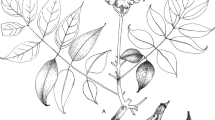Abstract
The usefulness of features of leaf hairs in distinguishing subgenera and sections is well documented in bothRhododendron andSolanum. In this analysis of the taxa ofSolanum sect.Basarthrum (23 species), and of a sample of closely related taxa from sect.Petota (22 species), it is shown that such features serve to delineate subsectional groups such as series and some species as well. SectionBasarthrum has an unexpected diversity of hair types. Although this group has been characterized by 2-celled “bayonet hairs”, more than one half of the taxa in the section bear multicellular “finger hairs”, and 3 species also possess branched hairs. Thus, major rearrangements of the species previously assigned to sect.Basarthrum are indicated or supported by pubescence features. The taxa studied from seriesEtuberosa andJuglandifolia (both of sect.Petota) show hair types that a) are relatively primitive for the section, and b) show linkage between sects.Petota andBasarthrum.
Similar content being viewed by others
References
Anderson, G. J., 1975: The variation and evolution of selected species ofSolanum sectionBasarthrum. — Brittonia27, 209–222.
—, 1977: The variation and evolution ofSolanum sect.Basarthrum. II. — Brittonia29, 116–128.
Anderson, G. J., 1979a: Systematic and evolutionary consideration ofSolanum sect.Basarthrum. — In:Hawkes, J. G., Lester, R. N., Skelding, A. D., (Eds.): The Biology and Taxonomy of theSolanaceae, 307–319. — Linnean Society Symposium Series No. 7. — London: Academic Press.
—, 1979b: DioeciousSolanum species of hermaphroditic origin is an example of a broad convergence. — Nature282, 836–838.
—,Gensel, P. G., 1976: Pollen morphology and systematics ofSolanum sect.Basarthrum. — Pollen et Spores18, 533–552.
-Levine, D. A., 1981: Three taxa constitute the sexes of a single dioecious species ofSolanum. — Taxon, in press.
Bitter, G., 1912:Solana nova vel minus cognita. V. — Repert. Spec. Nov. Regni Veg.11, 349–350.
—, 1913a:Solana nova vel minus cognita. VIII. — Repert. Spec. Nov. Regni Veg.11, 562–563.
—, 1913b:Solana nova vel minus cognita. IX. — Repert. Spec. Nov. Regni Veg.12, 1.
—, 1917:Solana africana II. — Bot. Jahrb.54, 424–425.
Brücher, H., 1966:Solanum caripense HBK (subsect.Basarthrum) in Venezuela. — Feddes Repert. Spec. Nov. Regni Veg.73, 216–221.
—, 1966: Die genetischen Reserven Südamerikas für die Kulturpflanzenzüchtung. — Theor. Appl. Genet.38, 9–22.
—, 1970: Chromosomenzahlen argentinischer, chilenischer und venezolanischer Wildkartoffeln (Solanum sect.Tuberarium). — Cytologia35, 153–170.
Correll, D. S., 1961: New species and some nomenclatural changes in sectionTuberarium ofSolanum. — Wrightia2, 169–197.
—, 1962: The Potato and its Wild Relatives. — Texas Research Foundation, Renner, Texas.
Dunal, F., 1852:Solanaceae. — InDe Candolle, A.: Prodromus ⋯13[1], 1–690.
Hawkes, J. G., Hjerting, J. P., 1969: The Potatoes of Argentina, Brazil, Paraguay, and Uruguay, a Biosystematic Study. — Annals of Botany Memoirs No. 3. — Oxford: Clarendon Press.
Heiser, C. B., Jr., 1964: Origin and variability of the Pepino (Solanum muricatum): a preliminary report. — Baileya12, 151–158.
—, 1969:Solanum caripense y el origen deSolanum muricatum. — Revta. Pol. (Quito, Ecuador)1, 1–7.
Seithe, A., 1979: Hair types as taxonomic characters inSolanum. — InHawkes, J. G., Lester, R. N., Skelding, A. D., (Eds.): The Biology and Taxonomy of theSolanaceae, 307–319. — Linnean Society Symposium Series No. 7. — London: Academic Press.
Seithe-v. Hoff, A., 1960: Die Haarformen der GattungRhododendron und die Möglichkeit ihrer taxonomischen Verwertung. — Bot. Jahrb.79, 297–393. Tafel 6–11.
—, 1962a: Die Haarformen der GattungRhododendron L. — Bot. Jahrb.81, 336.
Seithe-v. Hoff, A., 1962b: Die Haararten der GattungSolanum L. und ihre taxonomische Verwertung. — Bot. Jahrb.81, 261–335, Tafel 25–28.
- 1980:Rhododendron hairs and taxonomy. — In:Luteyn, J. L., O'Brien, M. E., (Eds.): Proceedings: International Rhododendron Conference, N.Y. Bot. Garden, May 15–17, 1978, pp. 89–115. — New York.
Author information
Authors and Affiliations
Rights and permissions
About this article
Cite this article
Seithe, A., Anderson, G.J. Hair morphology and the relationships of species inSolanum sect.Basarthrum . Pl Syst Evol 139, 229–256 (1982). https://doi.org/10.1007/BF00989327
Received:
Issue Date:
DOI: https://doi.org/10.1007/BF00989327




